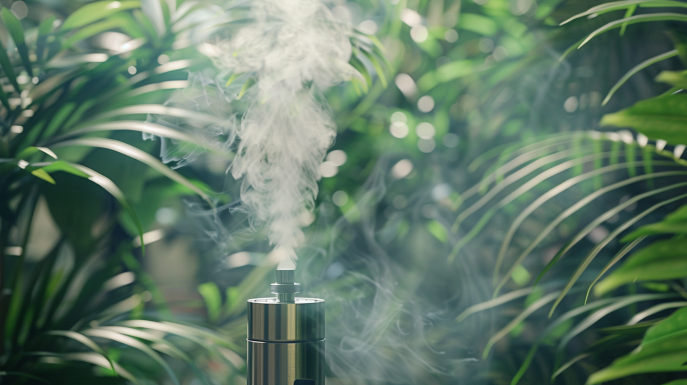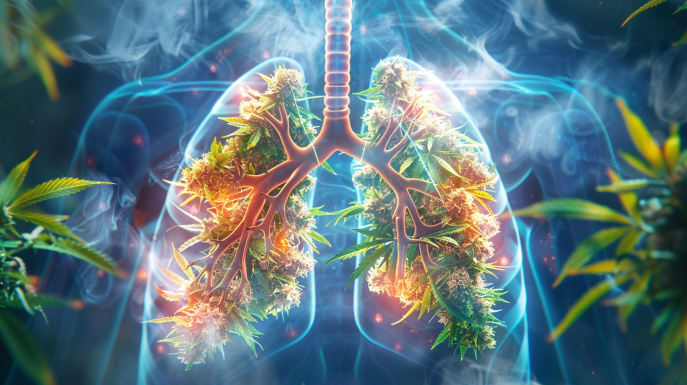Does smoking cannabis harm your lungs? Is vaping cannabis safer than smoking? These are queries that many cannabis users grapple with. Some cannabis users assert that smoking cannabis is not as detrimental as smoking tobacco, but is that the reality or just wishful thinking?
The Relationship Between Cannabis and Human Lungs
When we inhale, our muscles expand our lungs and air flows in from the outside. Inside our lungs, the air flows over a large surface area of specialized cells.
Oxygen is removed from the incoming air and transported into the body by the red blood cells, while carbon dioxide is expelled from the body during exhalation. When we smoke or vape cannabis, the cannabinoids are absorbed into our bloodstream, producing that familiar ‘high’ from cannabis.
Combustion Byproducts of Cannabis
When cannabis is burned, a variety of chemicals are released. The cannabinoids and terpenes are released and absorbed from the air that our lungs breathe in. However, when organic material is set on fire, harmful chemicals also emerge.
These include small particles produced during combustion: tar, carbon particles (soot), carbon monoxide, and complex (and potentially harmful) organic molecules are also absorbed. Many cannabis users believe that smoking cannabis isn’t as harmful as smoking tobacco.
However, the fact remains that almost the same combustion byproducts are released when smoking cannabis as when smoking tobacco. So, is it truly safer to smoke cannabis?
Smoking Cannabis Might Not Be As Harmful As We Feared
Despite the concerns associated with smoking cannabis, the American Medical Association published a report demonstrating that moderate cannabis smokers might have stronger lungs than non-smokers. How can this be possible?

You can find the complete study involving 5,000 participants here. However, it appears that moderate doses of cannabis allow for improved lung capacity and better airflow through the lungs. The study was more observational than explanatory.
What makes the study interesting and significant, though, is that it spanned over 20 years in 4 U.S. cities. It would be intriguing to find out why cannabis smoke seems to be less harmful than tobacco smoke. Does the cannabis oil act as a deterrent against lung diseases?
Or do the cannabinoids themselves possess protective traits? The potential answers could be valuable for medicine in general and particularly for lung specialists.
American Thoracic Society Study on Cannabis Smoking
Another interesting read on this topic is a study by the American Thoracic Society.
The study looked at long-term cannabis users and reached the following conclusion: “In a large cross-section of U.S adults, cumulative lifetime marijuana use up to 20 joint-years is not associated with adverse changes in measures of lung health.”
Vaping Cannabis vs. Smoking it
Even though there’s evidence suggesting that cannabis smoke might be less harmful than cigarette smoke, many people prefer to avoid combustion altogether. Vaping cannabis has several significant perks compared to smoking it.

When you vape cannabis, the ground herbs are gently roasted. Usually, the vapor temperature lies between 180 and 200° C. At this temperature, neither combustion nor smoke occurs. Instead, only the terpenes, cannabinoids and flavonoids are released from the herbs in the form of a slightly misty vapor.
When inhaled, the recreational/medical user gets high the usual way, but without any smoke or combustion involved. Another advantage of vaping cannabis is that it can be done without tobacco, unlike a cannabis joint (or spliff), which often contains tobacco.
Is vaping cannabis healthier than smoking it?
Many contemporary cannabis consumers prefer to vape their cannabis. There’s a feeling that vaping is healthier than smoking and it’s more discrete too.
When you smoke a joint outdoors, people can smell it from a distance. However, when you use a vaporizer, the aroma is much less and people nearby won’t notice it; plus, no smoke is produced. As a matter of fact, cannabis is 2 to 3 times more potent when vaped as opposed to when smoked.
That’s because vaping cannabis is much more efficient. When you smoke a joint, literally half of your cannabis goes up in smoke. But when you vape cannabis, you consume less than you would putting it in a joint – yet still get just as high.

An additional boon of vaping is the enhanced taste. A vaporizer produces a clear, crisp taste of cannabis, free from any interference of tobacco smoke. If you’ve spent months growing your own cannabis, you deserve to enjoy its full flavor – free from the taste of burning tobacco.
Cannabis Edibles – an alternative to smoking
Another alternative for smoking cannabis is edibles. Some cannabis consumers love the idea that they can reach a higher level of THC through the consumption of edibles than through smoking.
Not everyone likes cannabis edibles though, as it can be challenging to find the optimal dosage. Plus, it takes 1-2 hours to get high from cannabis edibles, whereas a vaporizer allows you to get high within minutes.

It’s worth noting that in places where cannabis has been legalized, cannabis-infused foods are becoming increasingly popular among consumers.
Smoking cannabis can introduce harmful chemicals similar to tobacco smoke into the lungs, but some studies suggest it may be less damaging than previously feared.
Yes, vaping cannabis is generally considered safer than smoking as it avoids combustion, reducing the intake of harmful byproducts and providing a cleaner inhalation of cannabinoids.
Cannabis combustion releases tar, carbon monoxide, and other harmful chemicals, similar to tobacco smoke.
Some studies, like one from the American Medical Association, suggest moderate cannabis vaping might improve lung capacity and airflow compared to non-smokers.
Vaping cannabis is more efficient, potentially healthier, and less noticeable than smoking. It allows users to enjoy a clearer taste of cannabis without the harmful byproducts of smoke.
Edibles offer a smoke-free alternative with potentially stronger and longer-lasting effects, though they require careful dosing and have a delayed onset.









